Tires
Replace or rotate tires in accordance with maintenance schedules and treadwear.
Checking tires
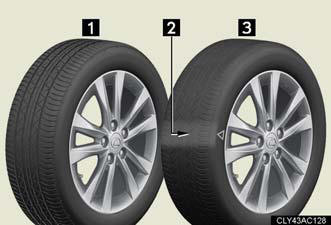
1. New tread.
2. Treadwear indicator.
3. Worn tread.
The location of treadwear indicators is shown by the “TWI” or “Δ” marks, etc., molded on the sidewall of each tire.
Check spare tire condition and pressure if not rotated.
Tire rotation
 If equipped with full-size spare
If equipped with full-size spare
tire
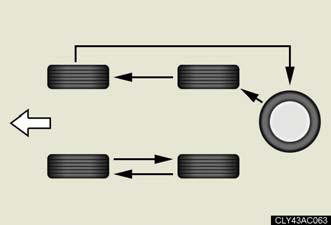
Rotate the tires in the order shown.
To equalize tire wear and extend tire life, Lexus recommends that tire rotation is carried out at the same interval as tire inspection.
 If equipped with compact spare
If equipped with compact spare
tire
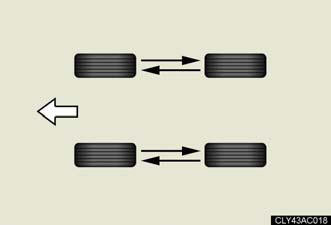
Rotate the tires in the order shown.
To equalize tire wear and extend tire life, Lexus recommends that tire rotation is carried out at the same interval as tire inspection.
The tire pressure warning system
Your Lexus is equipped with a tire pressure warning system that uses tire pressure warning valve and transmitters to detect low tire inflation pressure before serious problems arise.
Vehicles with compact spare tire: The compact spare tire is not equipped with the tire pressure warning valve and transmitters.
Installing tire pressure warning valves and transmitters
When replacing tires or wheels, tire pressure warning valves and transmitters must also be installed.
When new tire pressure warning valves and transmitters are installed, new tire pressure warning valve and transmitter ID codes must be registered in the tire pressure warning computer and tire pressure warning system must be initialized. Have tire pressure warning valve and transmitter ID codes registered by your Lexus dealer.
Initializing the tire pressure warning system
The tire pressure warning system must be initialized in the following circumstances:
When changing the tire inflation pressure by changing traveling speed or load weight, etc.
When the tire pressure warning system is initialized, the current tire inflation pressure is set as the pressure benchmark.
How to initialize the tire pressure warning system
1. Park the vehicle in safe place and turn the “ENGINE START STOP” switch OFF.
While the vehicle is moving, initialization is not performed.
2. Adjust the tire inflation pressure to the specified cold tire inflation pressure level.
Make sure to adjust the tire pressure to the specified cold tire inflation pressure level. The tire pressure warning system will operate based on this pressure level.
3. Turn the “ENGINE START STOP” switch to IGNITION ON mode.
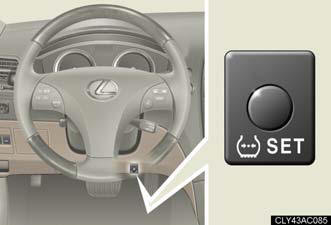
4. Push and hold the tire pressure warning reset switch until the tire pressure warning light blinks slowly 3 times.
5. Wait for a few minutes with the IGNITION ON mode, and then turn the “ENGINE START STOP” switch OFF.
Registering and selecting ID codes
Registering ID codes
2 sets of tire pressure warning valve and transmitter ID codes can be registered. Once a second set of tires is registered at “2nd”, you can switch between tire set settings simply by pressing the tire pressure warning select switch.
There are 2 settings:
“MAIN” position: The ID code of the tire pressure warning valve and
transmitter on the tires originally installed on the vehicle is registered.
“2nd” position: The ID code is not registered. When you replace a new set of tires, purchase tire pressure warning valves and transmitters from your Lexus dealer and have the new ID code registered by your Lexus dealer.
Selecting ID codes
When replacing tires, make sure to select the ID code set that matches the new tire set. If the tire pressure warning select switch is set to the wrong tire setting, the tire pressure warning system will not operate properly. After driving for about 20 minutes, the tire pressure warning light comes on after blinking for 1 minute to indicate a system malfunction.
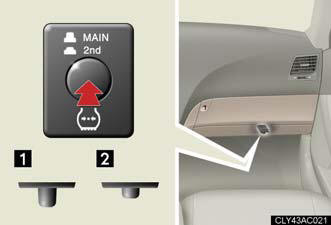
1. “MAIN”.
2. “2nd”.
When to replace your vehicle’s tires
Tires should be replaced if: - You have tire damage such as cuts, splits, cracks deep enough to expose the fabric or bulges indicating internal damage - A tire goes flat repeatedly or cannot be properly repaired due to the size or location of a cut or other damage If you are not sure, consult with your Lexus dealer.
Replacing tires and wheels
If the ID code of the tire pressure warning valve and transmitter is not
registered,
the tire pressure warning system will not work properly. After driving for about
20
minutes, the tire pressure warning light comes on after blinking for 1 minute to
indicate
a system malfunction.
Tire life
Any tire over 6 years old must be checked by a qualified technician even if
they
have seldom or never been used or damage is not obvious.
If the tread wears down below 0.16 in. (4 mm) on snow tires
The effectiveness of snow tires is lost.
Maximum load of tire
Check that the maximum load of the replacement tire is greater than 1/2 of
the
Gross Axle Weight Ratings (GAWR) of either the front axle or the rear axle,
whichever
is greater.
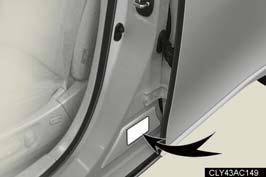
For the GAWR, see the Certification Label.
For the maximum load of the tire, see the load limit at maximum cold tire inflation pressure mentioned on the sidewall of the tire.
Tire types
1 Summer tires.
Summer tires are high-speed performance tires best suited to highway driving
under dry conditions. Since summer tires do not have the same traction
performance
as snow tires, summer tires are inadequate for driving on snow-covered
or icy roads. For driving on snow-covered roads or icy roads, the use of snow
tires
is recommended. When installing snow tires, be sure to replace all four tires.
2 All season tires.
All season tires are designed to provide better traction in snow and to be
adequate
for driving in most winter conditions, as well as for use year round. All season
tires, however, do not have adequate traction performance compared with
snow tires in heavy or loose snow. Also, all season tires fall short in
acceleration
and handling performance compared with summer tires in highway driving.
3 Snow tires.
For driving on snow-covered roads or icy roads, we recommend using snow tires.
If you need snow tires, select tires of the same size, construction and load
capacity
as the originally installed tires. Since your vehicle has radial tires as
original
equipment, make sure your snow tires also have radial construction. Do not
install
studded tires without first checking local regulations for possible restriction.
Snow tires should be installed on all wheels.
Initializing the tire pressure warning system
Initialize the tire pressure warning system with the tire inflation pressure
adjusted to
the specified level.
If you push the tire pressure reset switch accidentally
If initialization is performed, adjust the tire inflation pressure to the
specified level
and initialize the tire pressure warning system again.
When the initialization of the tire pressure warning system has failed
Initialization can be completed in a few minutes. However, in the following
cases,
the settings have not been recorded and the system will not operate properly. If
repeated attempts to record tire inflation pressure settings are unsuccessful,
have
the vehicle inspected by your Lexus dealer.
- When operating the tire pressure warning reset switch, the tire pressure
warning
light does not flash 3 times.
- After carrying out the initialization procedure, the tire pressure warning
light
blinks for 1 minute then stays on after driving for about 20 minutes.
Routine tire inflation pressure checks
The tire pressure warning system does not replace routine tire inflation
pressure
checks. Make sure to check tire inflation pressure as part of your routine of
daily
vehicle checks.
Tire pressure warning system certification
FCC ID: PAXPMV107J.
FCC ID: HYQ13BCX.
IC ID: 3729A-PMV107J.
IC ID: 1551A-13BCX.
 For vehicles sold in the USA
For vehicles sold in the USA
This device complies with Part 15 of the FCC Rules. Operation is subject to the
following
two conditions: (1) this device may not cause harmful interference, and (2)
this device must accept any interference received, including interference that
may
cause undesired operation.
FCC WARNING:
Changes or modifications not expressly approved by the party responsible for
compliance could void the user's authority to operate the equipment.
 For vehicles sold in Canada
For vehicles sold in Canada
Operation is subject to the following two conditions: (1) this device may not
cause
interference, and (2) this device must accept any interference, including
interference
that may cause undesired operation of the device.
CAUTION:
When inspecting or replacing tires
Observe the following precautions to prevent accidents.
Failure to do so may cause damage to parts of the drive train, as well as
dangerous
handling characteristics, which may lead to an accident resulting in death or
serious
injury.
- Do not mix tires of different makes, models or tread patterns. Also, do not
mix
tires of remarkably different treadwear.
- Do not use tire sizes other than those recommended by Lexus.
- Do not mix differently constructed tires (radial, bias-belted or bias-ply tires).
- Do not mix summer, all season and winter tires.
- Do not tow the vehicle with the compact spare tire installed.
When initializing the tire pressure warning system
Do not push the tire pressure warning reset switch without first adjusting the
tire
inflation pressure to the specified level. Otherwise, the tire pressure warning
light
may not come on even if the tire inflation pressure is low, or it may come on
when
the tire inflation pressure is actually normal.
NOTICE:
Repairing or replacing tires, wheels and tire pressure warning valves and
transmitters
When removing or fitting the wheels, tires or the tire pressure warning valve
and
transmitter, contact your Lexus dealer as the tire pressure warning valve and
transmitter
may be damaged if not handled correctly.
To avoid damaging the tire pressure warning valves and transmitters Do not use liquid sealants on flat tires.
Driving on rough roads
Take particular care when driving on roads with loose surfaces or potholes.
These conditions may cause losses in tire inflation pressure, reducing the
cushioning
ability of the tires. In addition driving on rough roads may cause damage to the
tires themselves, as well as the vehicle’s wheels and body.
If tire inflation pressures become low while driving Do not continue driving, or your tires and/or wheels may be ruined.
See also:
If you have a flat tire
Remove the flat tire and replace it with the spare provided.
Before jacking up the vehicle
Stop the vehicle on a hard, flat surface.
Set the parking brake.
Shift the shift lever to P.
Vehicles wi ...
Using the AUX adapter
This adapter can be used to connect a portable audio device and listen to
it
through the vehicle’s speakers.
Connect the portable audio
device.
Press .
Operating portable audio devices connec ...
Safety/Security Features
The Lexus LS 460 provides one of the most advanced and comprehensive
integrations of vehicle-safety technology today. New Active Front Headrests on
all models are designed to help mitigate whiplas ...
